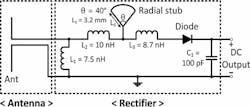Ambient RF Energy Supports Wireless Sensors
For a plethora of intelligent wireless sensors to function throughout our environment, new ways of powering these devices must be explored. The viability of several energy-harvesting techniques—ranging from solar, thermal, and piezoelectric to wireless—have been investigated by Sangkil Kim, Rushi Vyas, Jo Bito, Kyriaki Niotaki, Ana Collado, Apostolos Georgiadis, and Manos M. Tentzeris from the Georgia Institute of Technology, the University of Calgary, and the Centre Tecnologic Telecomunicacions, Spain. The group focused on the wireless energy harvesting of low-power, far-field, ambient ultra-high-frequency and cellular-band radiation.
Ambient RF energy may have the lowest power density of available energies. Yet it is a very cost-effective option for powering a wireless sensor. To explore this option, the research team used a broadband (512 to 566 MHz) log-periodic antenna with a realized gain of 7 dBi on average for capturing power in the ultra-high-frequency (UHF) digital TV bands in Tokyo. CST Microwave Studio was used to design and optimize the antenna. This log-periodic structure was fabricated on 1.6-mm FR4. Slots were cut into the antenna’s dipole elements to miniaturize the structure. Using inkjet-printed antenna structures on paper, the team made a quasi-omnidirectional antenna out of low-cost and lightweight material. The folder dual-band antenna is optimized at 915 MHz and 2.45 GHz, as the power density is much greater at these frequencies than it is in the spectrum dedicated to TV White Space. A single-stage rectifying circuit was used with this harvester to maximize RF-DC conversion efficiency.
Additionally, the researchers studied wireless near-field energy harvesting for on-body displays. A folded dipole on 1.57-mm FR4 was used to support a 38-×-380-mm 1:1 transformer, functioning as a balun, in order to balance the input of the antenna. A five-stage Dickinson RF-DC converter was integrated into the design and optimized for harvesting at the 400-to-500-MHz UHF band, generating 1.7 V on-body. See “Ambient RF Energy-Harvesting Technologies for Self-Sustainable Standalone Wireless Sensor Platforms,” Proceedings of the IEEE, Nov. 2014, p. 1649-1666.
About the Author
Jean-Jacques DeLisle
Jean-Jacques graduated from the Rochester Institute of Technology, where he completed his Master of Science in Electrical Engineering. In his studies, Jean-Jacques focused on Control Systems Design, Mixed-Signal IC Design, and RF Design. His research focus was in smart-sensor platform design for RF connector applications for the telecommunications industry. During his research, Jean-Jacques developed a passion for the field of RF/microwaves and expanded his knowledge by doing R&D for the telecommunications industry.

